Key takeaways:
- Understanding reluctant learners involves recognizing their underlying emotions, such as fear, frustration, and self-esteem issues, which can hinder engagement and motivation.
- Motivation is crucial for educational success; fostering it can lead to deeper connections with learning and prevent students from withdrawing.
- Effective strategies for engaging reluctant learners include incorporating their interests, using collaborative activities, and setting achievable goals to build confidence.
- Building relationships with students through genuine interest and celebrating their unique strengths enhances their engagement and participation in the classroom.

Understanding reluctant learners
Understanding reluctant learners requires recognizing that their hesitation often stems from fear or frustration. I recall a student who would freeze at the thought of a math test. Rather than being lazy or indifferent, she was paralyzed by the pressure to perform. Isn’t it crucial for us to identify those underlying emotions?
Many reluctant learners also struggle with self-esteem issues, which can create a cycle of avoidance. I remember another case where a young girl kept saying she wasn’t smart enough, despite her obvious talent in art. When we began connecting her love for drawing to the subjects she found daunting, it was transformative. How often do we overlook the strengths that could bridge gaps in learning?
Additionally, external factors like home life or peer influences can play a significant role. There was a time when I witnessed a boy disengage because he felt unsupported at home, leading to a lack of motivation overall. I ask myself, how can we as educators cultivate an environment that fosters not just academic growth, but emotional resilience as well? Understanding these dimensions is essential in reaching reluctant learners effectively.
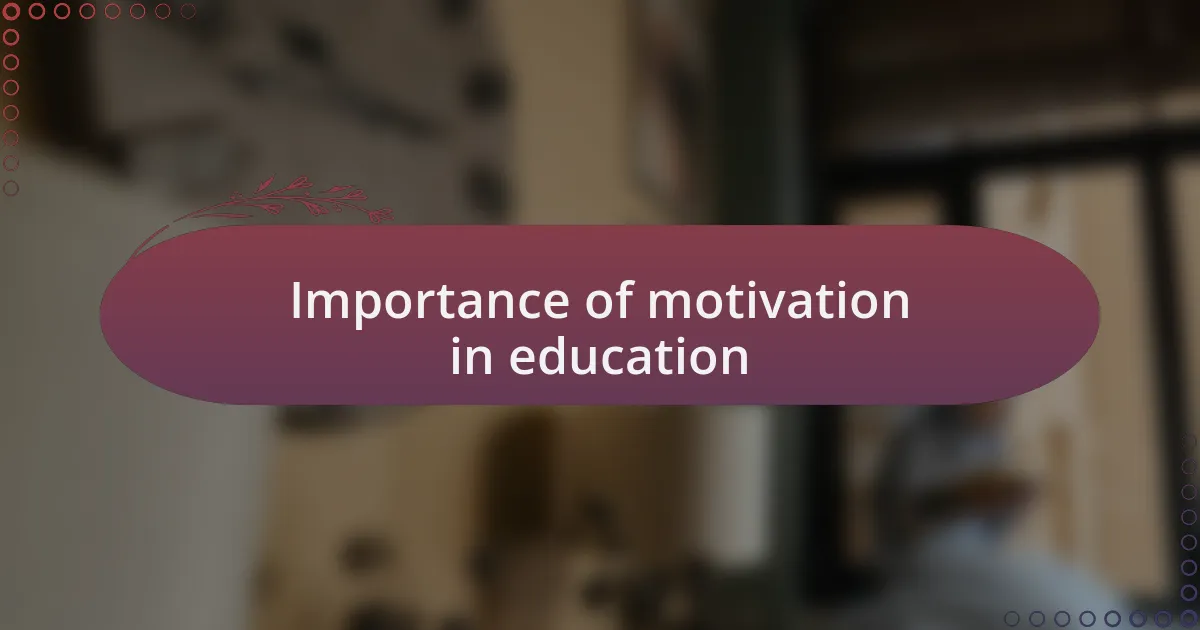
Importance of motivation in education
Motivation is the driving force behind all educational success. I often reflect on a classroom moment when a student lit up after mastering a difficult concept; that spark of understanding was more powerful than any grade. Isn’t it fascinating how motivation can ignite curiosity and lead to a genuine love for learning?
Without motivation, even the most comprehensive lesson plans can fall flat. I remember a group project where one student remained disengaged while others flourished. It struck me that the enthusiasm of the motivated students could not bridge the gap without addressing the underlying disinterest of that one peer. When we consider how pivotal motivation is, it becomes clear that fostering it should be a priority for every educator.
In more challenging circumstances, a lack of motivation can lead to a vicious cycle where students withdraw further from learning, impacting their long-term academic journey. I’ve seen this happen with students who had brilliant potential but felt overwhelmed by the pressure to succeed. Isn’t it our responsibility to break that cycle and find new ways to engage and inspire? Understanding and nurturing motivation is not just beneficial; it’s essential for cultivating resilient learners.
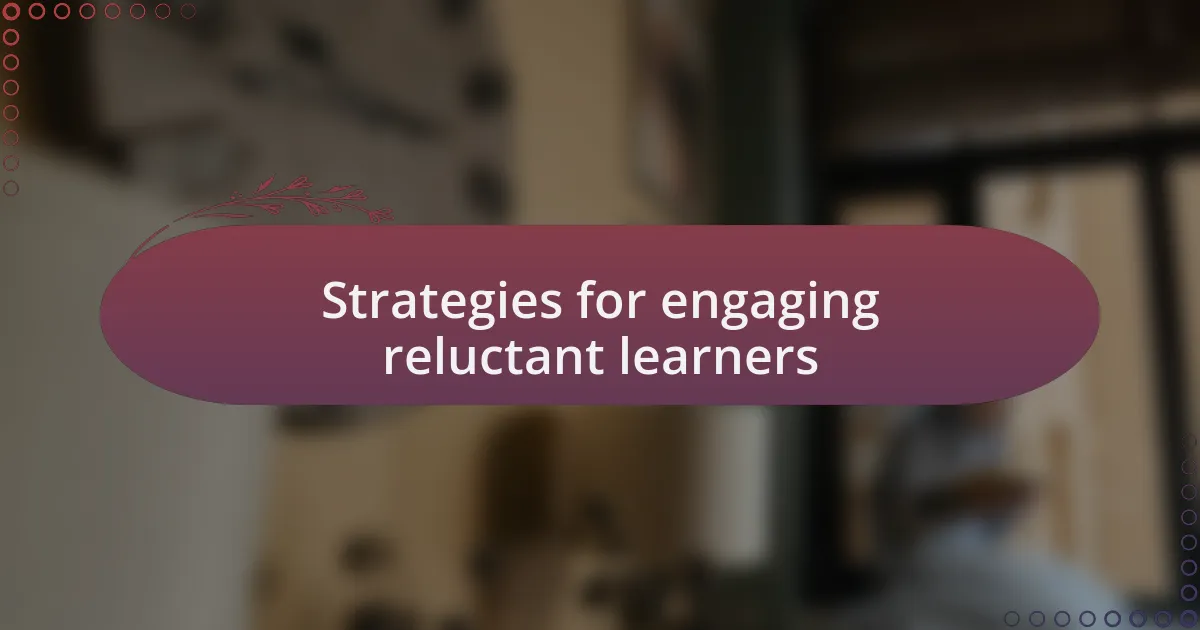
Strategies for engaging reluctant learners
One effective strategy I find invaluable is incorporating student interests into lessons. For instance, I once had a student who struggled in math, but when I learned about his passion for sports, I started using sports statistics to teach concepts like averages and percentages. It amazed me how quickly he became engaged; suddenly, math wasn’t just numbers to him; it was part of something he loved. Have you ever witnessed a moment when a connection clicked for a student? It can change everything.
Using collaborative activities is another technique that can draw in reluctant learners. I often arrange group challenges where students must rely on one another’s strengths to solve problems. I remember a particular project where students with different skills pooled their knowledge and creativity, creating an atmosphere of camaraderie. Witnessing their teamwork and enthusiasm made me realize that sometimes, learning together can remove the pressure and create a supportive space that fosters engagement.
Furthermore, I encourage setting achievable, short-term goals tailored to individual students’ needs. I had a student who always seemed reluctant to participate in discussions, but when I highlighted small successes, like answering one question per class, her confidence began to blossom. What I’ve seen is that celebrating these small victories can be a powerful motivator, helping reluctant learners recognize their potential and, most importantly, realize that they can succeed. Have you tried this approach with your students? It might just be what they need to shine.
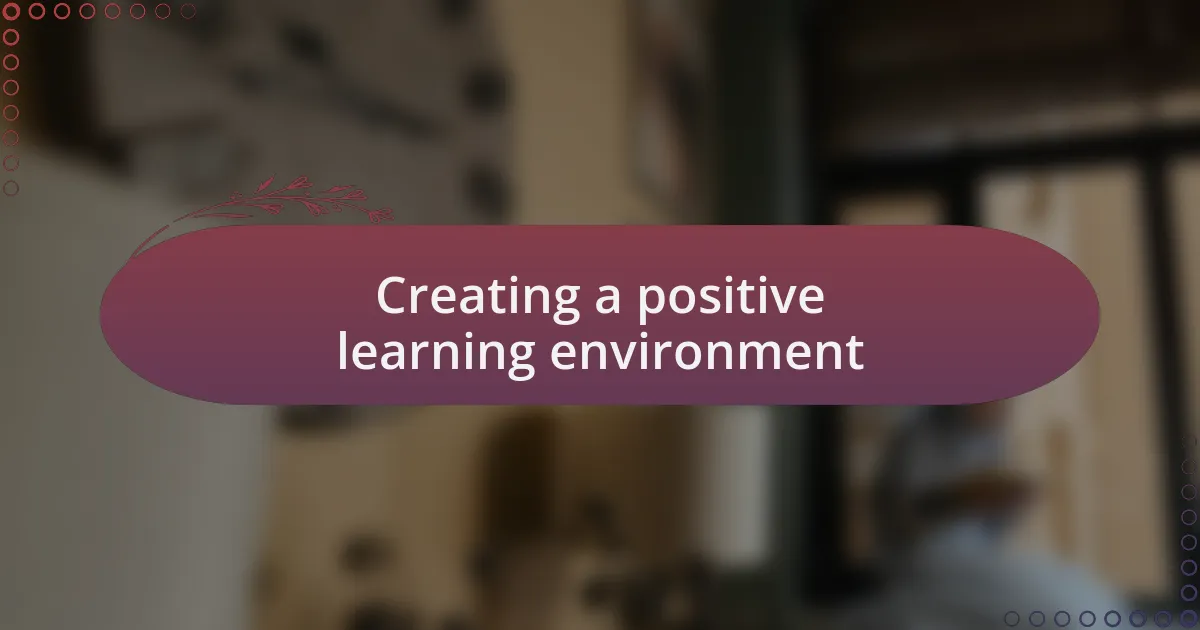
Creating a positive learning environment
Creating a supportive atmosphere is essential to fostering a positive learning environment. I recall a classroom where a student often sat in the back, disengaged and withdrawn. One day, I simply walked over and asked about their favorite hobby, and as we chatted, I noticed their demeanor change. It reminded me how a small act of genuine interest can pave the way for a student to feel valued and included, ultimately prompting them to participate more actively.
Another key element is maintaining a safe space for mistakes. I once encouraged my students to share their errors openly, which initially felt intimidating for some. However, I turned it into a learning moment by celebrating these missteps as part of the learning journey. I vividly remember one student laughing about their wrong answer, and that simple moment filled the room with comfort and openness. Isn’t it amazing how sometimes vulnerability can strengthen connections?
Lastly, I believe in the power of consistency and routine in a classroom. Establishing clear expectations helps students feel secure and more willing to engage. I once implemented a daily check-in, and it became a ritual that students looked forward to. This small structure fostered camaraderie and connection among them. How do you think regular routines could transform your learning environment?
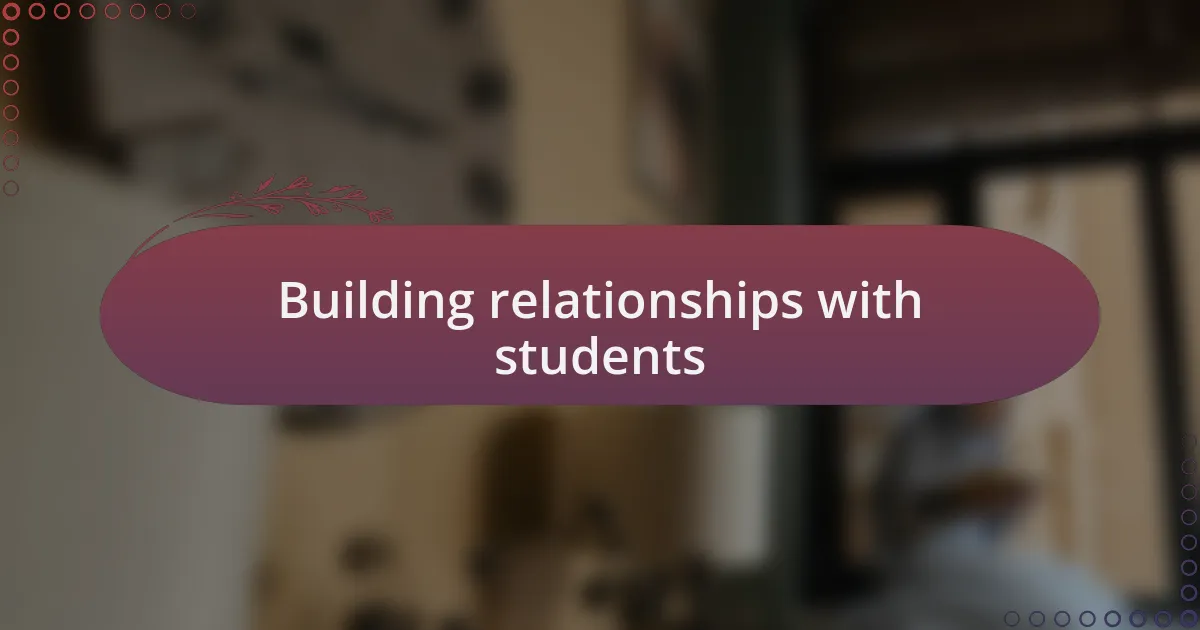
Building relationships with students
Building meaningful relationships with students begins with showing genuine interest in their lives. I remember a particular instance when I made an effort to learn about a shy student’s family background. This simple conversation blossomed into a warm relationship where they felt comfortable sharing ideas and struggles with me. The trust built through sincere engagement made them more willing to participate in class discussions. Don’t you think that when students feel seen, their engagement naturally flourishes?
Additionally, I’ve found that being approachable can make a world of difference. I once set aside a few minutes after each class for informal chats, and over time, students began to share not just their academic challenges but also their personal interests and aspirations. This openness helped me to tailor my lessons to their interests, creating a more personalized learning experience. Have you ever considered how just setting aside time for casual conversation could enrich your relationship with students?
Furthermore, I believe in the importance of celebrating each student’s unique strengths. During one project, I spotlighted different talents—whether it was creative thinking or problem-solving—that students brought to the table. I watched as their self-confidence surged, encouraging them to support each other more collaboratively. It’s fascinating how recognizing individual contributions can transform a group dynamic. How can you embrace and highlight the unique abilities of your students in your own teaching practice?
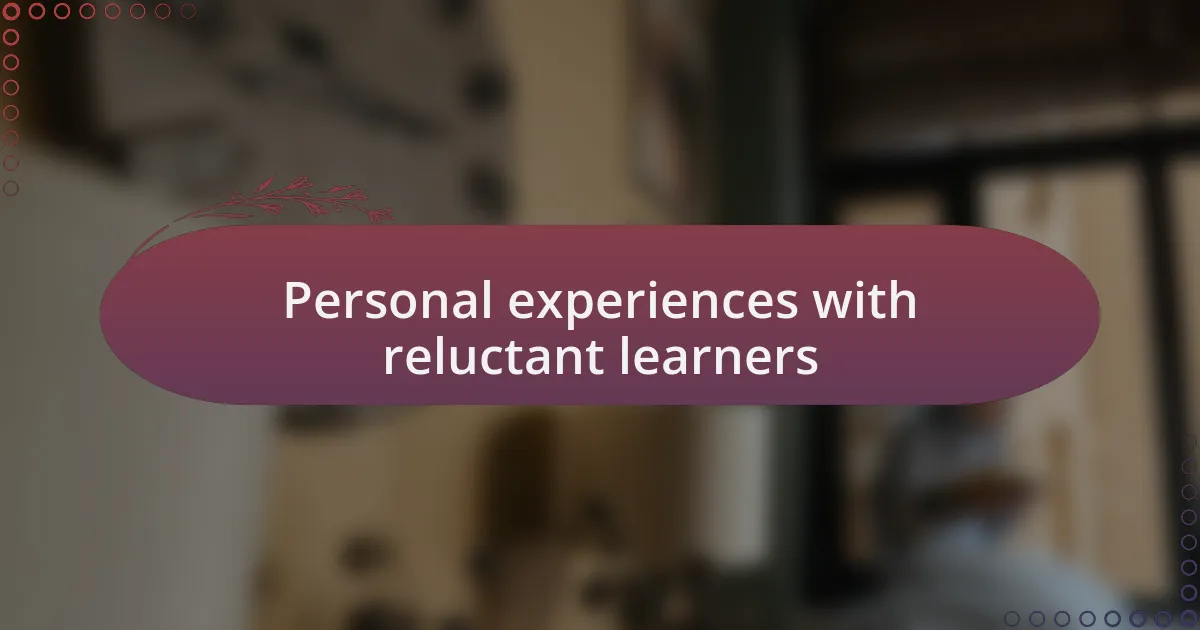
Personal experiences with reluctant learners
I vividly remember a student who seemed disengaged from the very start of the semester. He often slouched at his desk, headphones in, barely making eye contact. One day, I decided to break the routine and asked him about his favorite bands and what music meant to him. This simple conversation sparked a light in him; suddenly, he began to contribute to class discussions, drawing connections between lyrics and themes we were covering. Have you ever experienced how a small shift in focus can ignite a student’s interest?
Another instance that stands out to me was a group project where a typically reluctant learner was assigned a leadership role. Initially, I was concerned about his ability to motivate others, but I encouraged him to integrate a game element into the project. To my surprise, he embraced the challenge, using his love for gaming to engage his peers creatively. Watching him succeed not only transformed his confidence but also inspired others to take ownership of their learning. Isn’t it intriguing how we can discover hidden potential when we trust students with responsibility?
Often, I find myself reflecting on how I can better support reluctant learners in my classroom. I recall an emotional moment when one student, who rarely participated, brought in a family recipe to share with the class. As they explained the importance of the dish in their culture, I realized that when students connect their personal stories to learning, their reluctance fades away. Can you think of ways to weave personal narratives into your teaching to encourage participation?
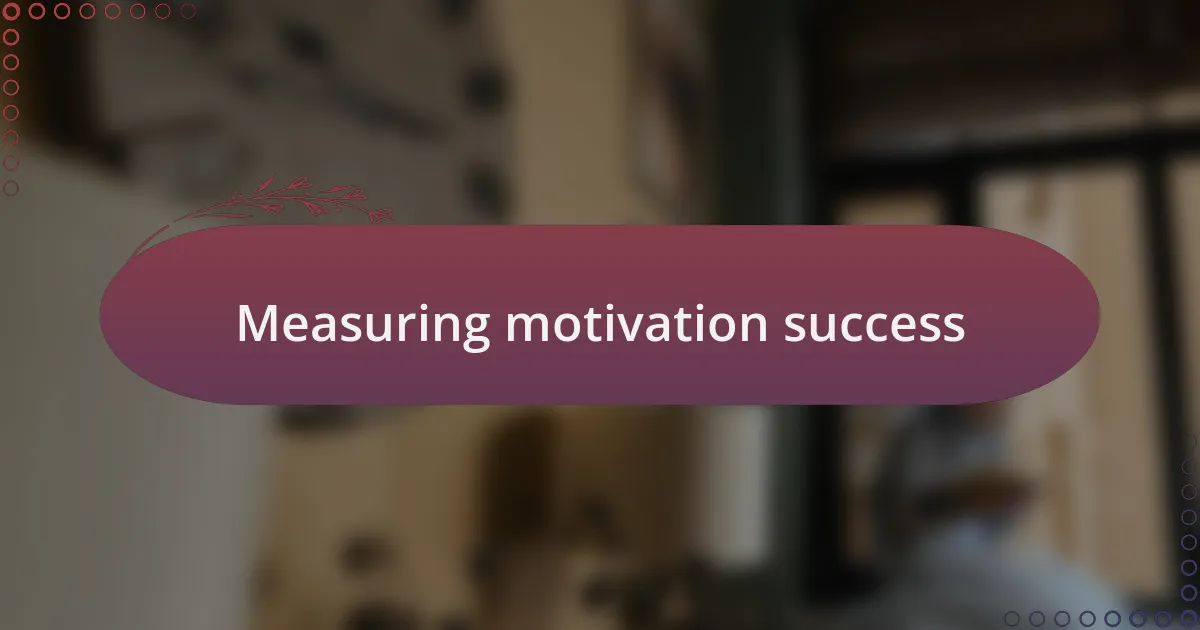
Measuring motivation success
Tracking motivation success often requires both qualitative and quantitative approaches. For instance, I like to use informal surveys after engaging activities to gauge how students felt about their learning experiences. When one reluctant learner shared that he felt “motivated” for the first time after a collaborative project, it really hit home for me—that’s a measure that can’t be overlooked.
Another effective method I’ve found is observing changes in engagement over time. Once, I noticed a previously shy student raising her hand more frequently in discussions. This shift didn’t just indicate a change in her participation; it signaled a deeper connection with the material. How often do we recognize these subtle indicators of success? They reveal so much about a student’s evolving mindset.
Finally, I always make it a point to reflect on the emotional responses of my learners. I recall a student who, after a series of motivational activities, shared how her self-esteem had improved. That kind of feedback is priceless; it not only demonstrates that my efforts made a difference but also reinforces the idea that emotional well-being is closely tied to motivation. Seeing students transform in this way compels me to continue exploring creative strategies. How about you? What measures do you use to ensure motivation is growing in your classroom?